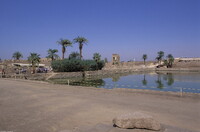Precinct of Amun-Re, Sacred Lake
unknown (Egyptian (ancient))

Download1A3-EG-K-TA-6-A2_cp.jpg (397.3Kb)
Date
-1554--1305Description
General view of the Sacred Lake, looking northeast, with the Gate of Nectanebo I in the distance (center); Sacred lake was a term for an artificial body of water within ancient Egyptian temple precincts from the Old Kingdom (ca. 2575-ca. 2150 BCE) to the Roman period (ca. 30 BCE-395 CE). Sacred lakes were usually fed by ground-water, differing in this from other kinds of temple waters such as stone-lined canals (connecting the temple with the Nile), and larger than the square or circular wells. There were five basic types of sacred lakes. In its strictest sense the term refers to a rectangular, stone-lined basin with stairs leading down to water-level (such as those at Dendara, Armant, Elkab, Medamud, Medinet Habu, Tanis, el-Tod and the Temple of Amun at Karnak). This type was sometimes flanked by a cultic kiosk (as at Dendara and el-Tod) or by a structure for housing waterfowl (as at Karnak). There are two sacred lakes at Karnak; one in the Precinct of Amun-Re and the other in the Precinct of Mut. The various types of sacred lakes served a number of cultic purposes. Source: Grove Art Online; http://www.groveart.com/ (accessed 1/19/2008)
Type of Work
pondSubject
deities, Egypt--Religion, New Kingdom (Egyptian)
Rights
Rights Statement
Licensed for educational and research use by the MIT community only
